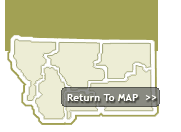

| Home | Communities | Accommodations | Places To Go | Things To Do | Site Map |
|
Glacier Country
Central Montana
Missouri River Country
Southwest Montana
Yellowstone Country
Southeast Montana
|

Hailstone National Wildlife RefugeRapelje MontanaListing Type: Wildlife RefugeCity: Rapelje Montana Region: Yellowstone Country 406-538-8706 http://mountain-prairie.fws.gov/refuges/mt/ |
Hailstone National Wildlife Refuge is part of the Big Lake Complex, a large drainage area beginning with Hailstone to the north and ending at the state-owned and managed Big Lake to the south. This complex is one of the most productive areas in central Montana for waterfowl. This area was established by Executive Order as a refuge and breeding ground for migratory birds and other wildlife.
A large alkaline lake, the Hailstone Refuge is in wide-open short grass prairie country dominated by rocky outcroppings and small grassy hills. This 1,913-acre refuge is noted primarily for its waterfowl (several thousand migration times) and shorebirds, commonly including mallards, gadwalls, trails, redheads, canvasbacks, American avocets, phalaropes, American white pelicans, grebes, and gulls. A good place to view water birds is a small hill that overlooks the lake. Several mudflats near the lake are a good spot for shorebirds. Pronghorn and sharp-tailed grouse are frequently seen in the upland areas, which are vegetated with sagebrush, greasewood, and native grasses. There is a black-tailed prairie dog town on the east side of the lake; watch for golden eagles, burrowing owls, and hawks preying on the dogs. Peregrine falcons also have been sighted here. Motorized boats prohibited on the lake.
Hailstone Basin was the location of a gun battle between Piegen and Crow warriors who enlisted the help of local ranchers from Park City on February 16, 1885. The Piegens had stole numerous horses from both parties and fled to this site where two ranchers and one Piegen warrior were killed in the ensuing battle.
While no recreation facilities are available, the refuge is open to hunting, hiking, and bird watching. In addition to compliance with all applicable state hunting regulations, non-toxic shot must be used to harvest waterfowl and upland game birds.
Directions: At Columbus, take Secondary Route 306 to Rapelje. From Rapelje, turn east on a county road and follow 4 miles to Hailstone Basin Road. Take this gravel road north about 1.5 miles to the refuge.
Hailstone National Wildlife Refuge
Charles M. Russell National Wildlife Refuge, Lewistown, MT 59457
|
A source for Montana Travel & Tourism Information
![]()